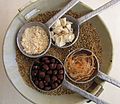Adansonia digitata
Adansonia digitata
Adansonia digitata, commonly known as the baobab, is a species of tree native to the African continent. It is one of the nine species of the genus Adansonia, and is the most widespread of the baobabs. The tree is known for its distinctive shape and large trunk, which can store significant amounts of water.
Description
Adansonia digitata is a large, deciduous tree that can grow up to 25 meters in height and 10 meters in diameter. The trunk is typically cylindrical and can be hollow, providing shelter for various animals and humans. The bark is smooth and grey, and the tree has a lifespan of several thousand years.
The leaves are palmate, with 5 to 7 leaflets, and are shed during the dry season. The flowers are large, white, and pendulous, blooming at night and pollinated by bats and insects.
Distribution and Habitat
Adansonia digitata is found in the dry, hot savannas of sub-Saharan Africa. It thrives in well-drained soils and is highly drought-resistant, making it well-suited to arid environments.
Ecological Role
The baobab tree plays a crucial role in its ecosystem. It provides food and shelter for a variety of species, including birds, insects, and mammals. The tree's flowers, fruit, and leaves are all utilized by different organisms.
Uses
The baobab tree is highly valued for its nutritional and medicinal properties. The fruit, known as "monkey bread," is rich in vitamin C, calcium, and antioxidants. The seeds can be pressed to extract oil, and the leaves are used in traditional medicine.
The bark is used to make rope, baskets, and cloth, while the hollow trunk can serve as a water reservoir or shelter.
Cultural Significance
The baobab is often referred to as the "Tree of Life" due to its ability to provide food, water, and shelter. It holds cultural significance in many African communities and is often featured in folklore and mythology.
Conservation
While Adansonia digitata is not currently endangered, it faces threats from habitat loss and climate change. Conservation efforts focus on protecting its natural habitat and promoting sustainable use of its resources.
Gallery
Related pages
Transform your life with W8MD's budget GLP-1 injections from $125.
W8MD offers a medical weight loss program to lose weight in Philadelphia. Our physician-supervised medical weight loss provides:
- Most insurances accepted or discounted self-pay rates. We will obtain insurance prior authorizations if needed.
- Generic GLP1 weight loss injections from $125 for the starting dose.
- Also offer prescription weight loss medications including Phentermine, Qsymia, Diethylpropion, Contrave etc.
NYC weight loss doctor appointments
Start your NYC weight loss journey today at our NYC medical weight loss and Philadelphia medical weight loss clinics.
- Call 718-946-5500 to lose weight in NYC or for medical weight loss in Philadelphia 215-676-2334.
- Tags:NYC medical weight loss, Philadelphia lose weight Zepbound NYC, Budget GLP1 weight loss injections, Wegovy Philadelphia, Wegovy NYC, Philadelphia medical weight loss, Brookly weight loss and Wegovy NYC
|
WikiMD's Wellness Encyclopedia |
| Let Food Be Thy Medicine Medicine Thy Food - Hippocrates |
Medical Disclaimer: WikiMD is not a substitute for professional medical advice. The information on WikiMD is provided as an information resource only, may be incorrect, outdated or misleading, and is not to be used or relied on for any diagnostic or treatment purposes. Please consult your health care provider before making any healthcare decisions or for guidance about a specific medical condition. WikiMD expressly disclaims responsibility, and shall have no liability, for any damages, loss, injury, or liability whatsoever suffered as a result of your reliance on the information contained in this site. By visiting this site you agree to the foregoing terms and conditions, which may from time to time be changed or supplemented by WikiMD. If you do not agree to the foregoing terms and conditions, you should not enter or use this site. See full disclaimer.
Credits:Most images are courtesy of Wikimedia commons, and templates, categories Wikipedia, licensed under CC BY SA or similar.
Translate this page: - East Asian
中文,
日本,
한국어,
South Asian
हिन्दी,
தமிழ்,
తెలుగు,
Urdu,
ಕನ್ನಡ,
Southeast Asian
Indonesian,
Vietnamese,
Thai,
မြန်မာဘာသာ,
বাংলা
European
español,
Deutsch,
français,
Greek,
português do Brasil,
polski,
română,
русский,
Nederlands,
norsk,
svenska,
suomi,
Italian
Middle Eastern & African
عربى,
Turkish,
Persian,
Hebrew,
Afrikaans,
isiZulu,
Kiswahili,
Other
Bulgarian,
Hungarian,
Czech,
Swedish,
മലയാളം,
मराठी,
ਪੰਜਾਬੀ,
ગુજરાતી,
Portuguese,
Ukrainian
Contributors: Prab R. Tumpati, MD










